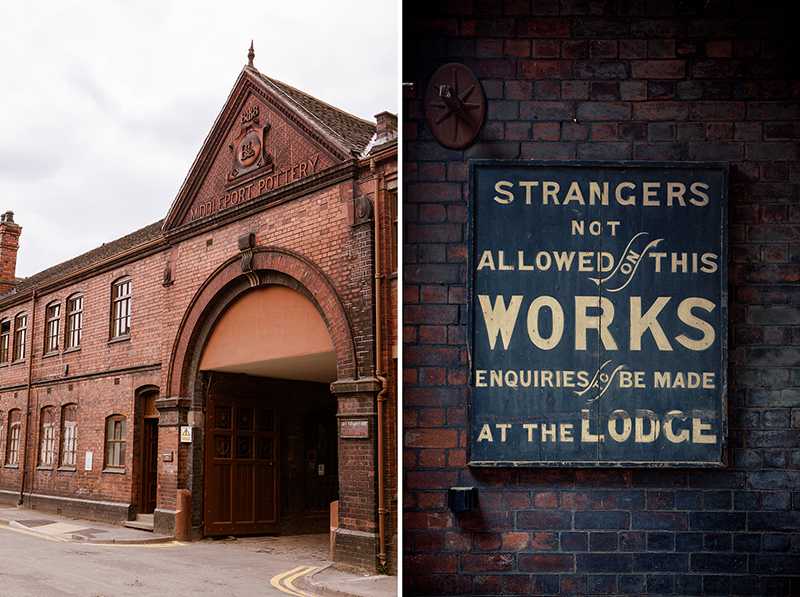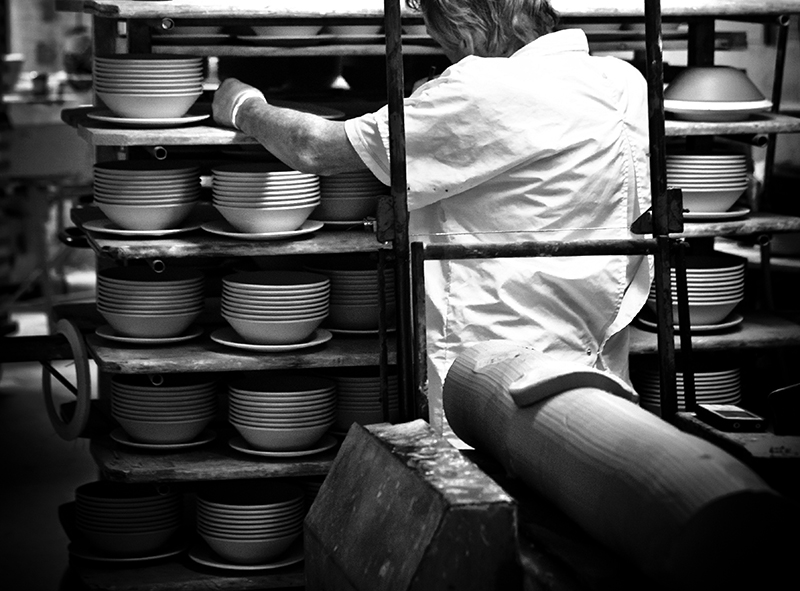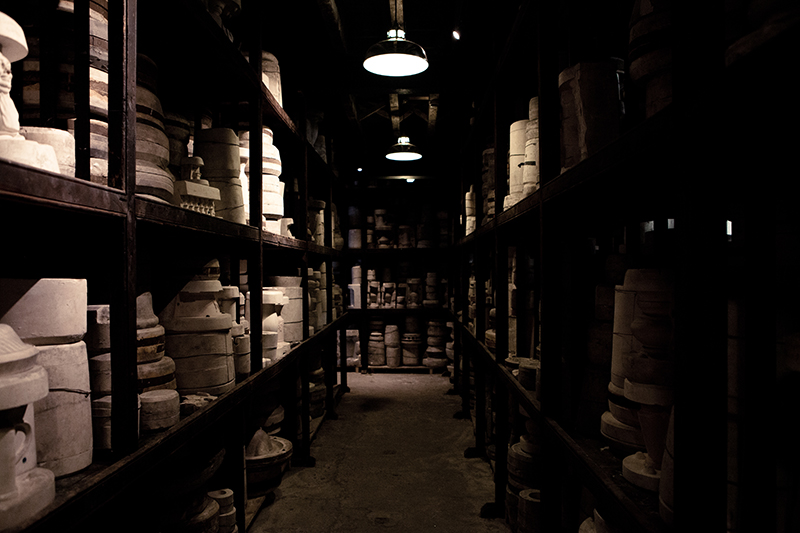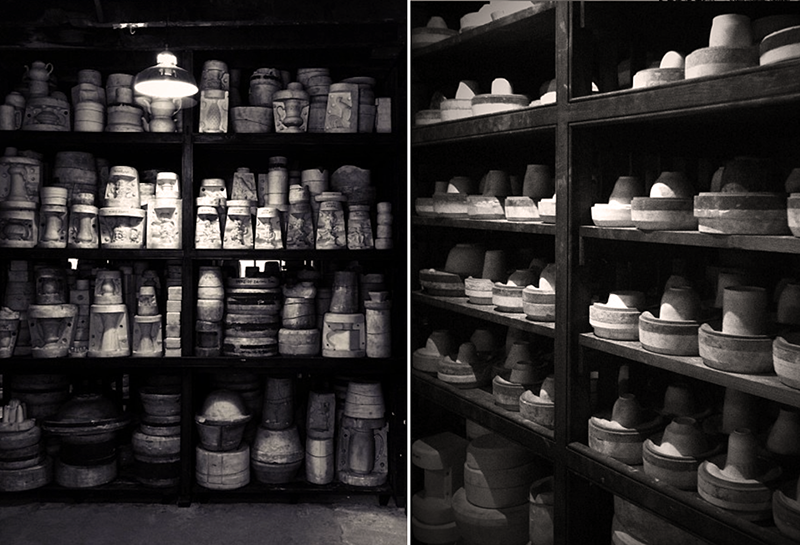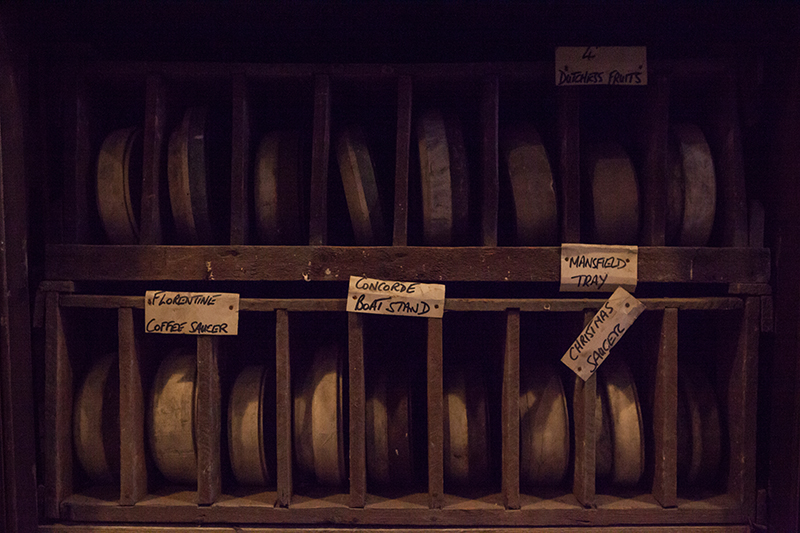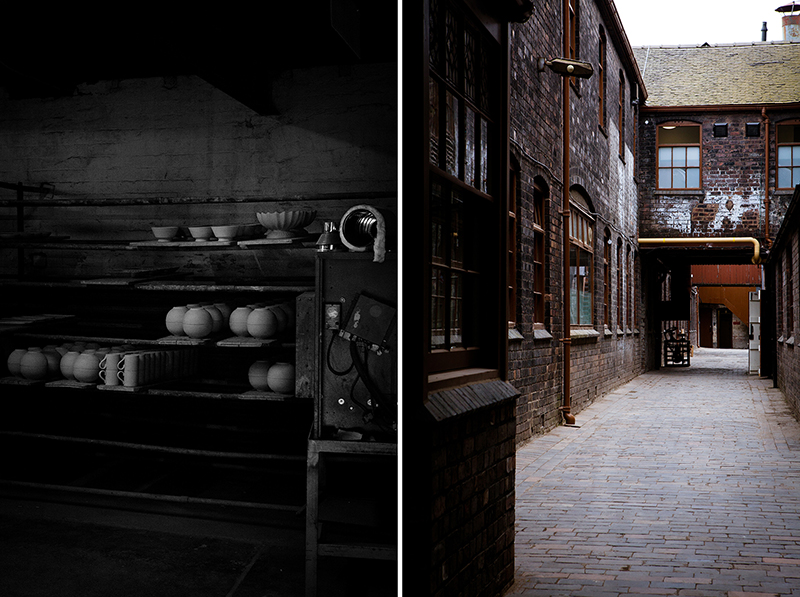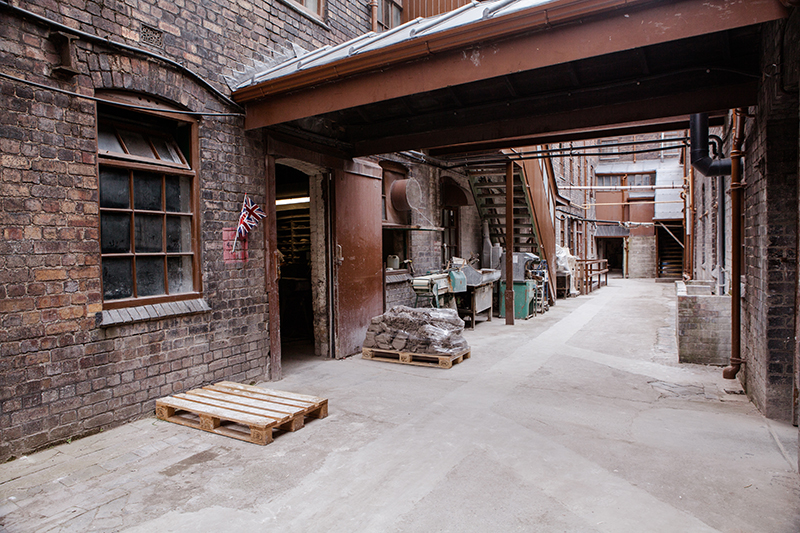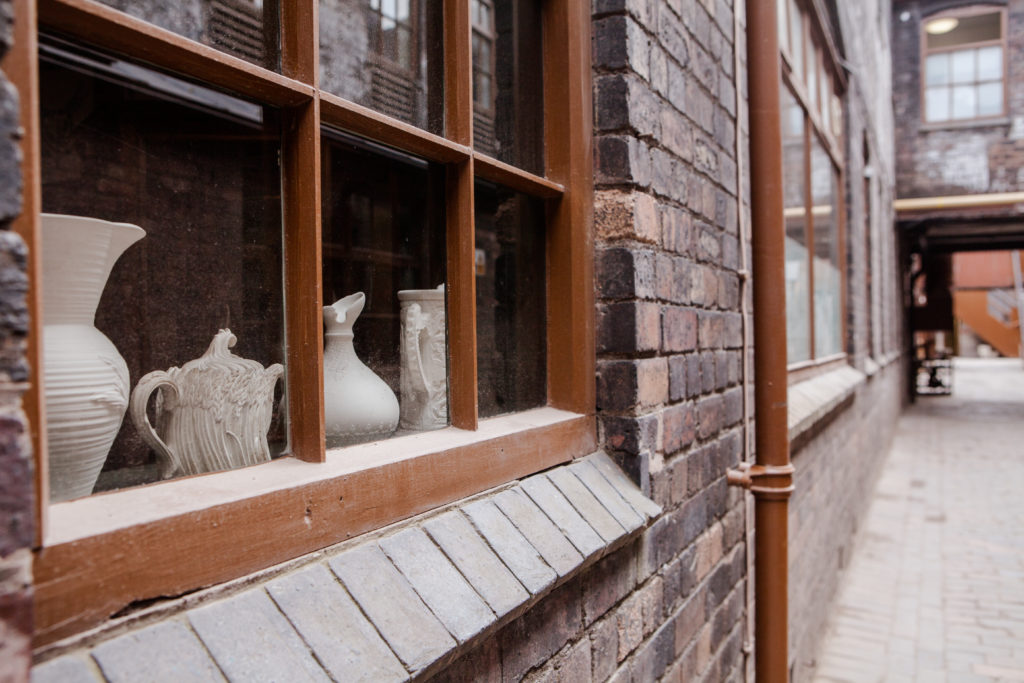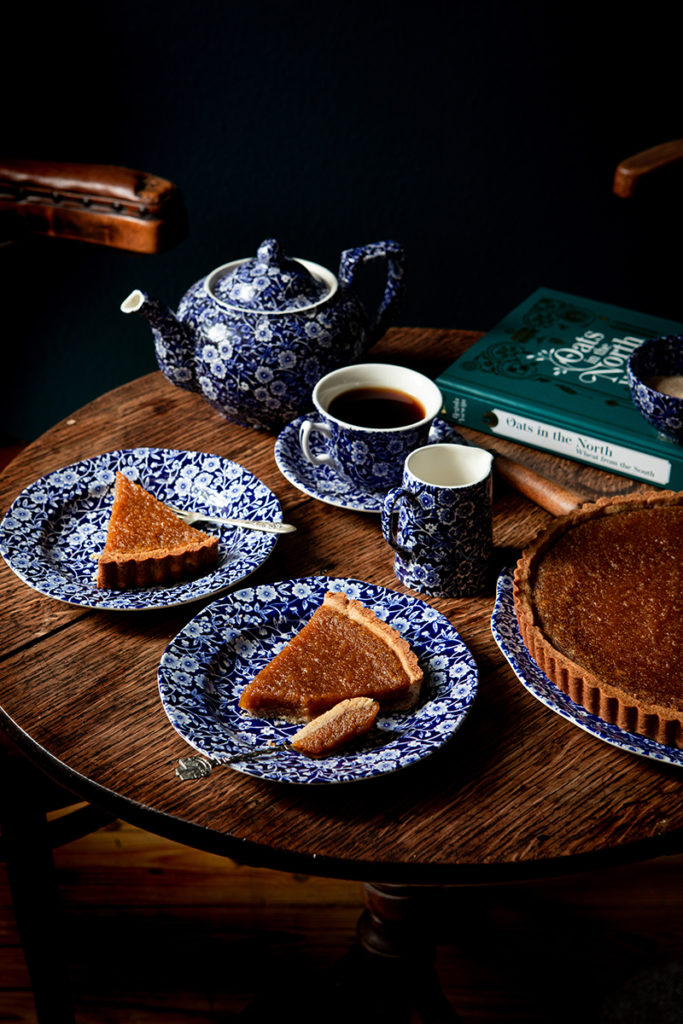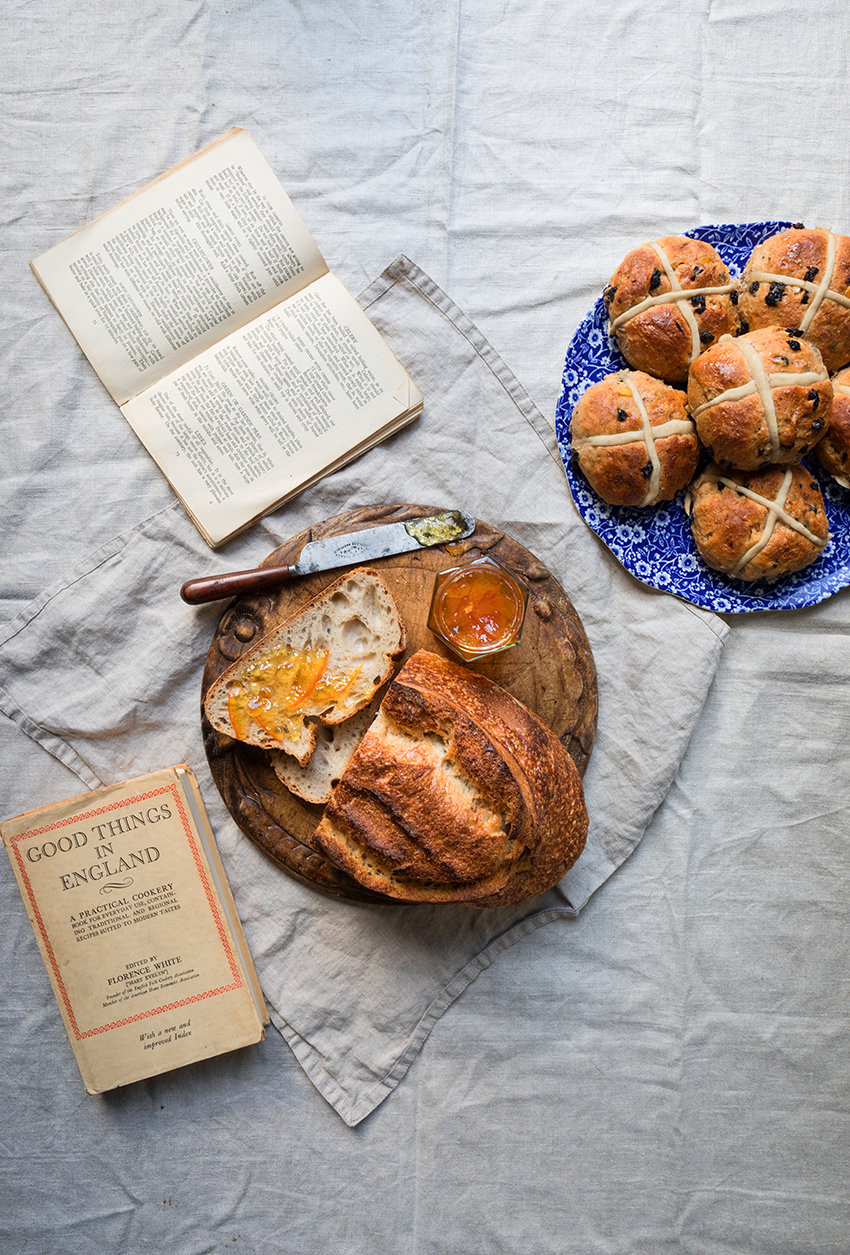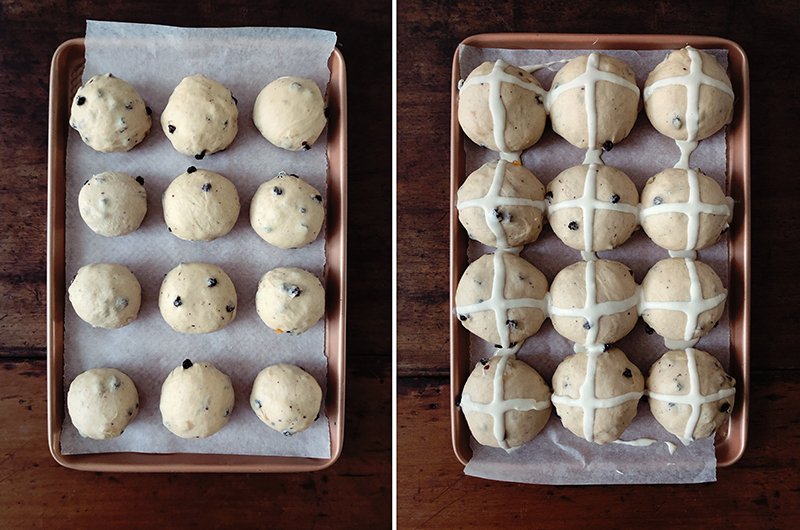The post Burleigh Pottery x Regula Ysewijn Competition appeared first on Miss Foodwise.
]]>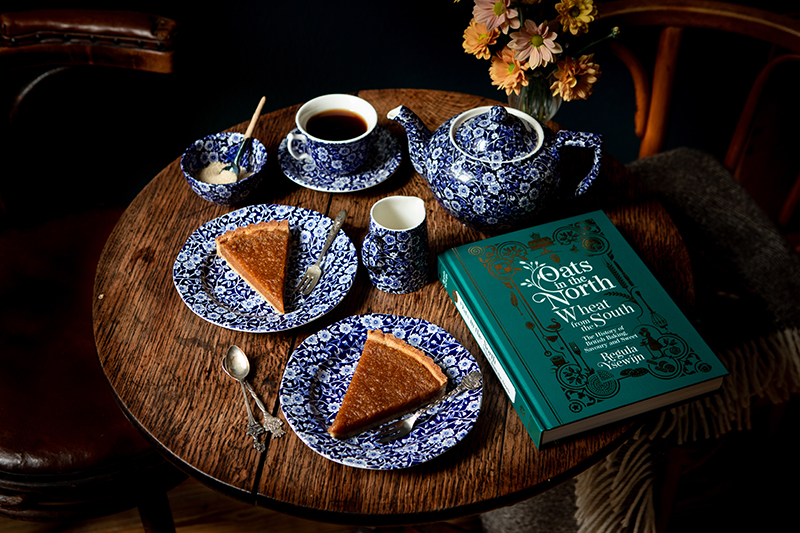 I am a huge Burleigh Pottery fan, as you will know if you have been following me on this website and my Instagram. I have used almost exclusively British pottery in my cookbooks Pride and Pudding and Oats in the North, Wheat in the South and a lot of that is Burleigh ware. That’s why Burleigh Pottery and I thought it was a super idea to team up to celebrate British pottery and my latest book on British baking! As an extra treat I’m finally sharing the pictures I took at Middleport Pottery many years ago, scroll down to find a reportage.
I am a huge Burleigh Pottery fan, as you will know if you have been following me on this website and my Instagram. I have used almost exclusively British pottery in my cookbooks Pride and Pudding and Oats in the North, Wheat in the South and a lot of that is Burleigh ware. That’s why Burleigh Pottery and I thought it was a super idea to team up to celebrate British pottery and my latest book on British baking! As an extra treat I’m finally sharing the pictures I took at Middleport Pottery many years ago, scroll down to find a reportage.
On to the giveaway! The winner will receive my book Oats in the North, Wheat in the South and Burleigh Pottery are offering this amazing Blue Calico (my favourite!) set worth over £250 consisting of:
A Blue Calico Teapot
A small milk jug
A sugar bowl
A large cake plate
2 dessert plates
2 teacups and saucers
All you need to do to be in the running to win is follow @burleighpottery and me @missfoodwise on Instagram and comment telling us why you’d love to win this incredible set of British pottery! You will have extra bonus entries if you share the competition page from @burleighpottery in an Instagram story, or if you bake my Treacle pumpkin tart recipe on the Burleigh website and share a picture of it on Instagram tagging us both (so we can see it and share!). Competition ends 31 oktober!
Burleigh ware is made by hand at the iconic Middleport Pottery in Stoke On Trent, it is the last working Victorian pottery in England. Burgess & Leigh was established in 1851. “Burleigh” is a combination of the two names William Leigh and Frederick Rathbone Burgess who were the founders. In my book Oats in the North, Wheat from the South’ which tells the history of British bakes and how the diverse climate of the British Isles influenced the growth of cereal crops and the development of a rich regional baking identity, you’ll read the story of the staple food of the pottery workers in the North of England and how these bakes are a fantastic relevant and healthy breakfast or lunch option today.
But since Halloween or Samhain is upon us I wanted to create a treacle tart with pumpkin for a very English pumpkin pie for this occasion. This recipe was adapted from the treacle tart recipe my latest book ‘Oats in the North, Wheat from the South’. Combining breadcrumbs with a sweet syrup in baked goods dates from before the 19th century, but the treacle tart that we know today came into existence sometime after the invention of the iconic golden syrup in 1883. It’s called “treacle tart” and not “golden syrup tart” because “treacle” is the general term for by-products of the sugar-refining process. Pecans are a nice addition to the tart crust, but don’t hesitate to replace them with more flour. See recipe on the Burleigh Pottery website here >
A couple of years ago I had the huge privilege to visit Middleport Pottery for a unique inside look into its Victorian buildings. Everything was covered in a thin layer of white dust, huge slabs of clay ready by the door. It was quiet and where there were people working, it felt like it was even quieter. The orange brickwork of the pottery was a bright light on a grey day which felt more like oktober than june. Behind an unassuming door I found a treasure trove of moulds, some over a century old. There were moulds for teacups, plates but also elaborate jelly moulds and other decorative pieces. The layer of dust on them acted like a blanket, where they rest until they can be used and produced again. The sleeping pottery of Middleport.
The only regret I have is that no one told us about the canal on the other side of the building, a place where barges come and go and where you can see the unique tower-high factory chimneys. I hope that one day, when this pandemic is over, I can travel here again, to walk by the streams in the beautiful Peak District and to once again enter the archway of Middleport pottery and make my photo reportage complete.
The post Burleigh Pottery x Regula Ysewijn Competition appeared first on Miss Foodwise.
]]>The post Brighton Rock Cakes – from Oats in the North, my new book appeared first on Miss Foodwise.
]]>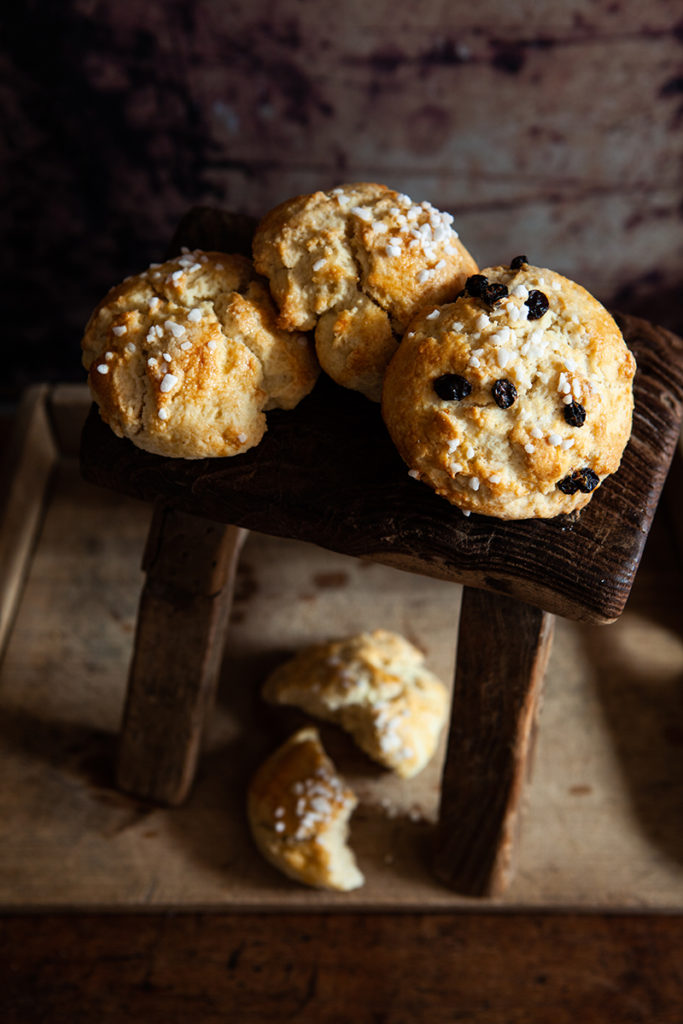 Recipe and extract from Oats in the North, Wheat from the South, published with Murdoch Books and available here >
Recipe and extract from Oats in the North, Wheat from the South, published with Murdoch Books and available here >
Usually these buns appear as ‘Rock cakes’ or ‘Rock buns’ in old cookery books, but in 1854 two recipes for Brighton rock cakes appeared in George Read’s The Complete Biscuit and Gingerbread Baker’s Assistant. Read gives a recipe for Brighton rock cakes and another for Brighton pavillions. The latter are made the same way as Brighton rock cakes, but are finished with a topping of currants and coarse sugar that, he says, should be ‘as large as a pea’.
You can still buy Brighton rock cakes in the seaside town of Brighton at the Pavilion Gardens Café. The open-air kiosk at Brighton Pavilion has been selling Brighton rock cakes since 1940, and possibly even longer if we look at Read’s recipe from 1854. Rock cakes are popular throughout Great Britain and Northern Ireland, and often appear in literature. In Harry Potter and the Philosopher’s Stone, Hagrid serves them to Harry and Ron, and Agatha Christie also mentions them in more than one novel.
I wanted to share this recipe in publication week of my new book Oats in the North, Wheat from the South because currently I am missing the sunny Brighton beach, the buzzing pier, and the busy Brighton lanes with its independent shop walhalla. I miss the days without worry when we drove over to the UK for a weekend, antiquing, walking, eating… When the Corona crisis is over I’m planning a trip, but I wonder how we will feel post Corona, will we be free of worry or will the way we live change?
But for now, we can bake, do join my #bakecorona on social media.
This recipe only uses one egg, in a time when eggs are dear this recipe might be a solution, other recipes from the book which can be handy during shortages are the Soda bread – to save yeast, the Parkin – to save sugar, the Cornish Heavy cake NO eggs at all, Yorkshire parkin – just oat flour needed, the fat rascalls – just 1 egg needed, Swiss roll – no baking powder but lots of eggs, Flapjack – uses just oats or leftover muesli. And to save an egg, I use an egg less in my pound cake! Happy baking…
This recipe for Brighton rock cakes contains candied cedro, but most rock cakes only contain currants, so you can easily leave it out.
Recipe from Oats in the North, Wheat from the South, published with Murdoch Books and available here >
For 6 rock cakes
- 225 g plain (all-purpose) flour
- 100 g raw cane (demerara) sugar or white sugar
- 1 tsp baking powder
- 1/4 tbsp mixed spice
- pinch of sea salt
- 75 g chilled butter, diced
- 1 egg
- 3 tbsp full-fat milk
- 50 g currants
- 30 g candied cedro (optional)
- 3 glacé cherries, halved, to garnish (optional)
- nibbed sugar, to garnish (optional)
Method
Preheat your oven to 200°C (400°F) and line a baking tray with baking paper.
Mix the flour, sugar, baking powder, mixed spice and salt in a large bowl. Add the butter and rub it into the flour mixture until it has the consistency of breadcrumbs.
Stir in the egg, then add enough milk to bring the dough together without making it too wet. If the dough is too dry to press together, add a teaspoon of milk. Fold the currants and candied cedro through the dough. Form six rock cakes using two forks – this will help achieve a rugged, rocky look. Place on the baking tray and decorate with the cherries and sugar, if using. Bake in the middle of the oven for 15 minutes until the rock cakes have a golden blush.
The post Brighton Rock Cakes – from Oats in the North, my new book appeared first on Miss Foodwise.
]]>The post Hot Cross Buns – The Tale Of English Buns # 2 appeared first on Miss Foodwise.
]]>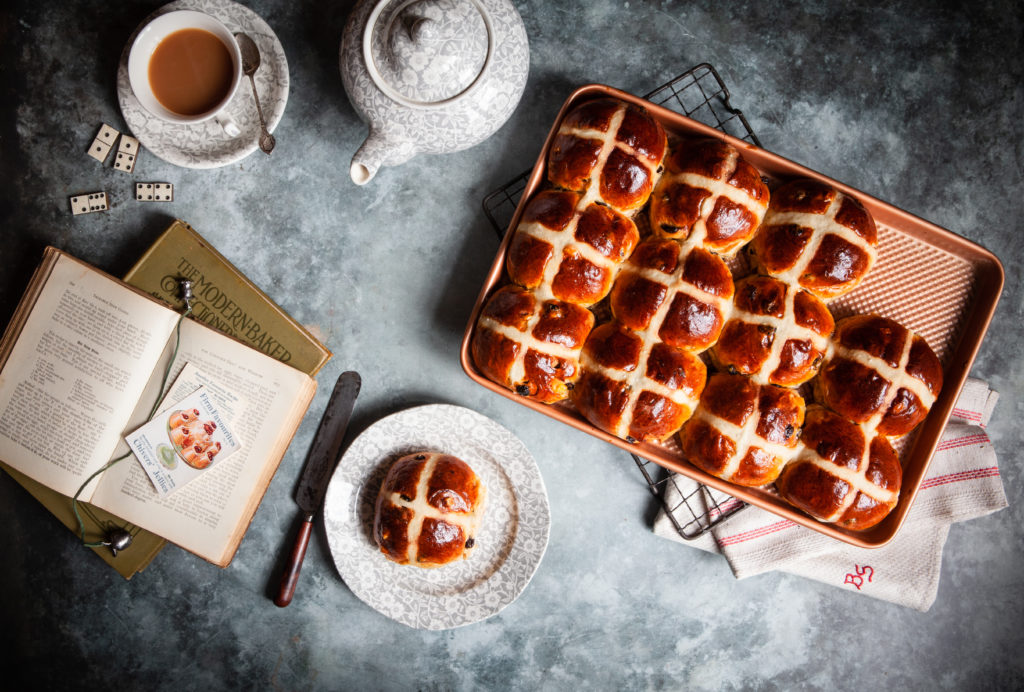 Bake them on Good Friday: The history and tales behind these spiced buns are plenty and intriguing, steeped in folklore dating back as far as Anglo-Saxon Britain. This is perhaps one of the most iconic of buns. Recipe from my new book Oats in the North, Wheat from the South, out with Murdoch Books (2020)
Bake them on Good Friday: The history and tales behind these spiced buns are plenty and intriguing, steeped in folklore dating back as far as Anglo-Saxon Britain. This is perhaps one of the most iconic of buns. Recipe from my new book Oats in the North, Wheat from the South, out with Murdoch Books (2020)
Every year well before Easter Marks & Spencer starts piling up Hot Cross Buns from chocolate & salted caramel to blueberry and marmalade. Marmalade I can understand as you do add candied orange peel to the dough, but chocolate & salted caramel and blueberry just creates a whole different bun, the cross being the only reminder of a traditional Hot Cross Bun. But what is traditional or original with a recipe as old as this one? If you scroll down to the recipe you might discover I too dare to add something which isn’t traditional from time to time.
The tradition of baking bread marked with a cross is linked to paganism as well as Christianity. The pagan Saxons would bake cross buns at the beginning of spring in honour of the goddess Eostre – most likely being the origin of the name Easter. The cross represented the rebirth of the world after winter and the four quarters of the moon, as well as the four seasons and the wheel of life.
The Christians saw the Crucifixion in the cross bun and, as with many other pre-Christian traditions, replaced their pagan meaning with a Christian one – the resurrection of Christ at Easter.
According to Elizabeth David, it wasn’t until Tudor times that it was permanently linked to Christian celebrations. During the reign of Elizabeth I, the London Clerk of Markets issued a decree forbidding the sale of spiced buns except at burials, at Christmas or on Good Friday.
The first recorded reference to ‘hot’ cross buns was in ‘Poor Robin’s Almanac’ in the early 1700s.
‘Good Friday come this month, the old woman runs. With one or two a penny hot cross buns.’
This satirical rhyme was also probably the inspiration of the commonly known street vendors cry:
‘Hot cross buns, hot cross buns!
One ha’penny, two ha’penny, hot cross buns!
If you have no daughters, give them to your sons,
One ha’penny, two ha’penny, hot cross buns!’
A century later the belief behind the hot cross bun starts to get a superstitious rather than a religious meaning.
In London’s East End you can find a pub called The Widows Son, named after a widow who lived in a cottage at the site in the 1820s. The widow baked hot cross buns for her sailor son who was supposed to come home from the sea on Good Friday. He must have died at sea as he never returned home, but the widow refused to give up hope for his return and continued to bake a hot cross bun for him every year, hanging it in her kitchen with the buns from previous years.
When the widow died, the buns were found hanging from a beam in the cottage and the story has been kept alive by the pub landlords ever since a pub was built on the site in 1848.
For whatever reason or belief you choose to bake a batch of hot cross buns on this Good Friday, it will most likely be to enjoy them with your loved ones. May it be for Eostre, Easter, the beginning of a much awaited spring or as a superstitious amulet for when you set sail, bake them with love!
This recipe is a revised version from one that appeared years ago on this site. I advise to use this one.
So here is how you bake your own:
Hot Cross Buns
What you will need
15 g (½ oz) dried yeast
300 ml (10½ fl oz) lukewarm full-fat milk
500 g (1 lb 2 oz) strong white bread flour
60 g (2¼ oz) raw (demerara) sugar or white sugar
1 tsp ground cinnamon
½ tsp ground mace
¼ tsp ground nutmeg
1/8 tsp allspice
1/8 tsp ground ginger
1/8 tsp ground coriander
70 g (2½ oz) butter, at room temperature, cubed
1 egg
5 g (1/8 oz) fine sea salt
150 g (5½ oz) currants
50 g (1¾ oz) candied citrus peel
2 egg yolks + 2 tbsp milk, for egg wash
For the crosses
140-160 ml (5¼ fl oz) water (if your flour is old it needs more water, if fresh 140 will be enough)
75 g (2½ oz) plain (all-purpose) flour
For a 39 x 27 cm (15½ x 10¾ inch) baking tin (if you don’t want the buns to attach to one another while baking, use a larger tray or bake in two batches)
For the shiny glaze:
Melt 60 g plain white sugar in 5 tbsp water
Method:
Add the yeast to the lukewarm milk and stir briefly and gently to activate it. The yeast will start to foam up in clusters, which means it is ready for use. Combine the flour, sugar and spices in a large bowl or the bowl of an electric mixer fitted with a dough hook and put the butter on top. Pour half of the yeast mixture over the butter and start kneading. When the milk and butter are completely absorbed, add the rest of the yeast mixture, along with the egg. Knead for 5 minutes, then let the dough stand for a few minutes (at this point it will be very wet). Add the salt and then the currants and candied peel and knead for 10 minutes, scraping the dough off the dough hook and side of the bowl if needed, until the dough has come together in a smooth and elastic dough that is not too dry but also not terribly wet.
Cover the dough and set aside for 1 hour until it has doubled in quantity.
Meanwhile, line the baking tin with baking paper. Mix the water and flour into a thick batter for the crosses and scoop it into a piping bag with a small nozzle and cover until needed.
Divide the dough into 12 equal pieces. Take a piece of dough and lightly flatten it on your work surface, then pull the outer parts in like a purse and gently squeeze together like a dumpling so that the dough can no longer split open while rising.
Turn the dough over so the squeezed ends are on the bottom. It should be nice and smooth on top – if not, flatten it and start again. Place in the baking tin and continue shaping the other buns, adding them to the tin to form neat rows.
Cover the tray of buns with a light cotton cloth and wrap it in a large plastic bag (I keep one especially for this purpose). Rest the dough for 1 hour or until the buns have doubled in size. Towards the end of the resting time, preheat the oven to 210°C (410°F).
Brush the buns generously with the egg wash, then carefully pipe a cross onto each bun. Transfer to the oven and bake for about 20-30 minutes until golden brown. (if you don’t want to egg wash, just brush on the sugar syrup as mentioned in the recipe, or do both!)
The buns are best eaten on the day they’re made. The next day they can be revived in a hot oven for a few minutes. You can also freeze the baked buns, thaw and then pop them in a hot oven for a few minutes.
These buns are excellent halved, then toasted and spread with copious amounts of farmhouse butter.
Freeze for up to a month. Leftover buns make a perfect Hot Cross Bun and Butter pudding, see my recipe here >
*Letting the dough rest for a while without salt is called an “autolyse”. It allows for enzymes to do part of the gluten development before you start to actually knead it. Adding salt with the yeast can kill it or slow down the process. This way it forms a developed dough more quickly.
RECIPE FROM MY BOOK Oats in the North, Wheat from the South (The British Baking Book (US), Brits Bakboek (NL-BE)) – You can order a copy here >
You might also enjoy (more buns of course):
For Bath Buns go here >
For Cinnamon buns go here >
For Santa Lucia Buns go here
The post Hot Cross Buns – The Tale Of English Buns # 2 appeared first on Miss Foodwise.
]]>